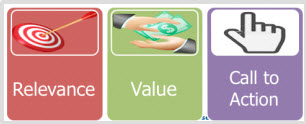Your boss says you need to generate more student leads and it is your job to figure out how to get them.Most college and university marketing managers would respond to this challenge by looking to their traditional lead generation options – general advertising, PPC, SEO, SEM local event marketing, etc – and determine where they could get the best impact with the budget they have at hand. Often overlooked in this scenario is an extremely effective online marketing strategy called Conversion Rate Optimization or CRO.
Essentially CRO is the process of increasing the performance of your existing web pages, through content and design refinement and testing, to increase goal conversion rates (i.e. lead generation) from your existing visitor traffic.
Definition – Conversion optimization or conversion rate optimization is a method of creating an experience for a website or landing page visitor with the goal of increasing the percentage of visitors that convert into customers. It is also commonly referred to as CRO.
Source: Wikipedia
At this point in discussing CRO with general marketing types, the question often comes up, “Why do we have to do this? I thought that our recent redesign of the website dramatically improved its design, form and function. Do you mean we have to keep revising pages?” Well, the short answer is yes. Your new design and new pages are probably great but if you want your pages, calls to action, forms, registration funnels and landing pages to perform at the highest level, you must upgrade them to operate as such. That’s what CRO does. It’s sort of like buying a beautiful new sports car out of a dealership and then taking it directly to your high performance mechanic to upgrade various parts to run it on an Indy racetrack. So how do you do CRO?
The CRO process involves four main steps:
- Identifying opportunities to make improvements to your pages that you think will improve their performance
- Testing them to quantify the impact of the changes and confirm that they are having the intended result,
- Implementing those improvements and
- starting the cycle over again to keep continuously improving your overall site’s performance.
Identifying opportunities to improve the conversion performance of your pages For detailed guidance on this topic I refer you to the work of Brian Eisenberg, one of the founding fathers of CRO. One of his guiding principles is that of the conversion trinity, that being the three key factors to consider to successfully improve your click-throughs or conversions. See Eisenberg’s blog post on this topic for a more details (and the source of the paragraph below).
Eisenberg’s Conversion Trinity includes, 
- Relevance – i.e. Are you relevant to my wants/needs/desires (search query)? Have you maintained scent/ad consistency?
- Value – i.e. Do I know why you are the right solution for me? Have you explained your value proposition/offer well?
- Call to action – i.e. Is it obvious what I need to do next? Have you given me the confidence to take that action?
Simply stated, if you wish to improve conversions on any particular page, carefully consider these three page factors and identify ways to improve one or more of them. Once you have your best “hypothesis” of what will most likely improve its performance, create a variation page that includes the improvement and test it.
Google Analytics Content Experiments can then be used to set-up and conduct an A/B test of the two pages. It is still fairly early days for this recently released Google product so it’s still a work in progress. It has a few kinks and not all of its operational assumptions are fully know yet but regardless it is a very powerful testing tool and will continue to improve. So you still may be skeptical that CRO can make that significant an impact on your overall page performance and specifically your lead generation numbers, so let’s take a look at a real example, that produced some pretty dramatic results.
This test was on a call to action button on the landing page for a US PPC campaign for a large community college in the states. It is a high volume PPC campaign which allowed for the test to be concluded within one week, at a 99% confidence level. To focus the story (and to protect the confidentiality of the client), I have only included the call to action buttons from the original and the test pages. A click on these buttons submitted the prospect student’s request for information and personal contact information. Content Experiments sets up and measures the A/B test against a particular goal that you define. In this case the goal of the test was the thank-you page presented to a prospect who successfully entered their contact information into the lead generation form. Everything else on the two test pages was exactly the same.
The original call to action button looked like this: ![]()
The variation call to action button looked like this: ![]()
The hypothesis for improvement to the button addressed two of Eisenberg’s Conversion Trinity factors:
- Value – The button offered more specific value to the prospect by including the verb “Get” and by specifically identifying the “Info Package”.
- Call to Action – Black text was used to improve readability and bring more visual emphasis to the button vs. the rest of the page.
Here are the results of the test as provided by Google Content Experiments within Google Analytics:  The new button dramatically outperformed the original button with a very high confidence level. It doubled the conversion rate and produced more than twice as many leads during the test period.
The new button dramatically outperformed the original button with a very high confidence level. It doubled the conversion rate and produced more than twice as many leads during the test period.
Over 6 days the new button produced 29 leads, the old button produced 13.
Conversions increased by 121%.
This example makes CRO look fairly simple but it’s not. In fact it is much more complicated that changing an image, some text or a background colour. In countless examples where a test’s results seemed certain, I have been surprised and been wrong about the outcome. There are certainly some general best practices that will give you improvements in results but even the experts in the field will tell you not to make assumption about your tests, to always focus on developing a hypothesis based on the key conversion factors and test your pages thoroughly.
So the next time you are reviewing your lead generation and recruitment performance metrics and are reminded of your need for more leads, don’t limit your thinking to investing your budget on advertising, PPC or events. Take a hard look at your site’s key pages where you generate most of your lead conversions and deeply consider how you can improve them. You might be surprised by how many more leads you can convert from you existing traffic.
We would love to hear about your experiences with optimizing your recruitment and related goal producing pages. What is the biggest surprise you have had with respect to results from one of your tests?





